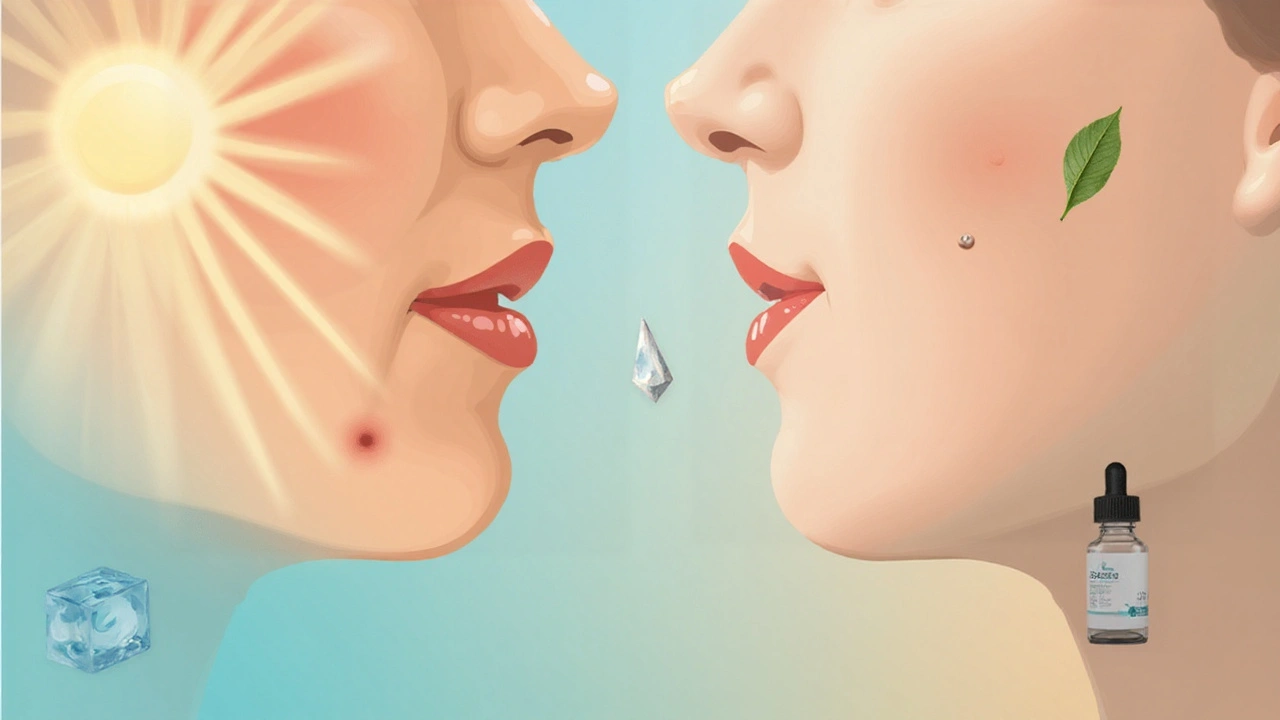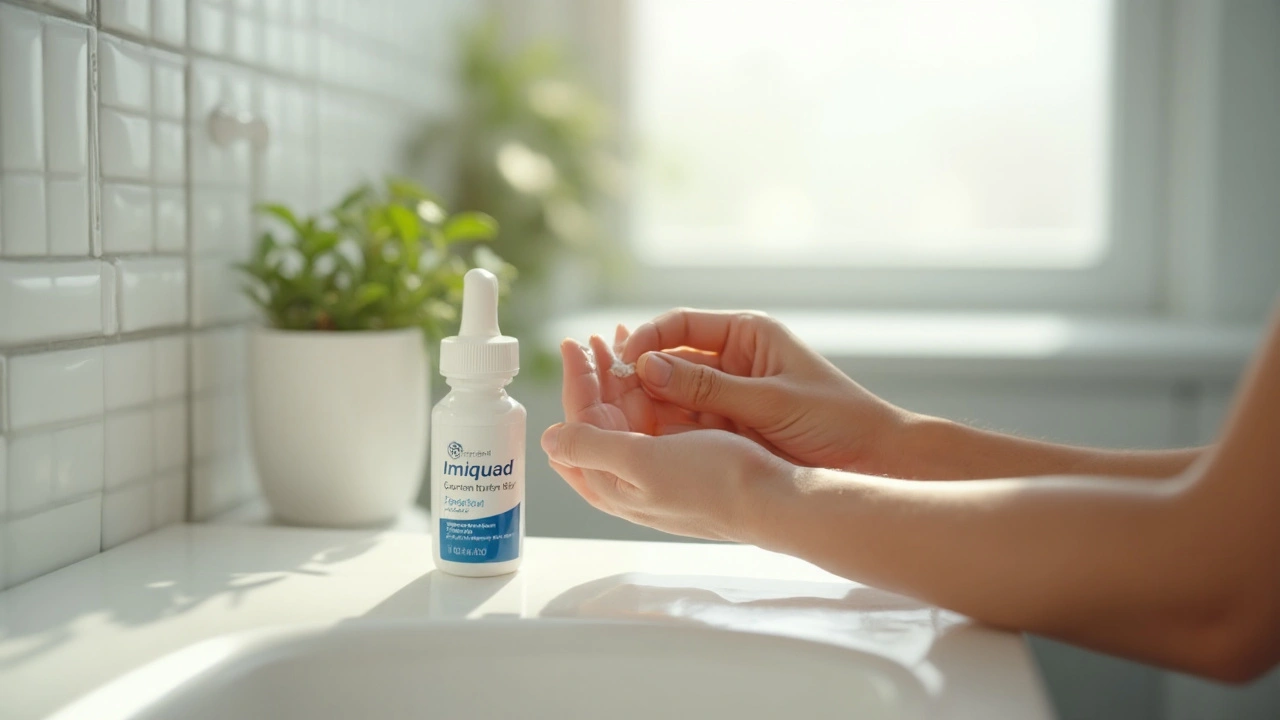TL;DR:
- Imiquad Cream contains imiquimod, a topical immune‑modifier used for actinic keratosis, genital warts and superficial basal cell carcinoma.
- Apply a thin layer once daily (or as prescribed), usually before bedtime, and wash off after 8‑12hours.
- Typical side effects: redness, itching, swelling, and flu‑like symptoms; serious reactions are rare but need medical attention.
- Avoid using on broken skin, and protect treated area from excessive sun.
- Alternatives include 5‑fluorouracil, photodynamic therapy, or surgical excision, each with its own pros and cons.
What Is Imiquad Cream?
Imiquad Cream is a prescription‑only gel that delivers the active ingredient imiquimod. Imiquimod isn’t an antibiotic or a steroid - it works by stimulating your body’s own immune system to fight abnormal cells on the skin. When you apply the cream, it triggers local production of interferon‑alpha and other cytokines, which help clear viral infections and precancerous cells.
The formulation is a 5% imiquimod cream, packaged in a single‑use tube that protects the product from light and air. Because it’s a medication that acts on the immune response, it can cause visible inflammation - that’s a sign it’s doing its job.
Approved Uses and Treatment Goals
In Australia, Imiquad is registered for three main indications:
- Actinic keratosis (AK): Rough, scaly patches that arise from chronic sun exposure. Left untreated, AK can turn into squamous cell carcinoma.
- External genital and perianal warts caused by human papillomavirus (HPV).
- Superficial basal cell carcinoma (sBCC) that isn’t deeply invasive.
Each condition has a slightly different treatment protocol, but the core goal is the same: eliminate the lesion while preserving surrounding healthy skin. Clinical trials in 2022‑2023 showed clearance rates of 80‑90% for AK when used for a 16‑week course, and around 70% for genital warts after a 4‑week regimen.
How to Use Imiquad Cream: Step‑by‑Step Guide
Follow these steps to maximise effectiveness and minimise irritation:
- Read the prescription label. Your dermatologist will specify the duration (usually 2‑4weeks for warts, up to 16weeks for AK).
- Wash the treatment area. Use mild soap and water, pat dry. Do not apply on cracked or broken skin.
- Apply a thin layer. Squeeze a pea‑sized amount onto a fingertip and spread evenly over the lesion(s). Less is more - a thick layer won’t work faster and may increase irritation.
- Leave it on. Most regimens advise keeping the cream on for 8‑12hours, then washing off with warm water. If you’re using the nightly schedule, apply before bedtime and wash off in the morning.
- Protect the area. After washing off, avoid sun exposure. Use broad‑spectrum sunscreen (SPF30+) on surrounding skin, and wear protective clothing if you’ll be outdoors.
- Stick to the schedule. Skipping applications can reduce efficacy. If you miss a dose, apply it as soon as you remember, unless it’s within 12hours of the next dose - then just skip the missed one.
Tip: Keep a small calendar or phone reminder. Most patients miss doses simply because they forget.

Common Side Effects and Safety Precautions
Because Imiquad works by revving up the immune system, local skin reactions are expected. Here’s what to watch for:
- Redness, swelling, itching, or burning. Usually peaks around day3‑5 and fades after a few days if the area is left alone.
- Crusting or scabbing - a sign the lesion is breaking down. Do not pick at scabs.
- Flu‑like symptoms (fever, chills, headache) - more common with extensive treatment areas.
If you experience any of these, try the following:
- Apply a cool, damp cloth for 10‑15minutes to soothe.
- Use over‑the‑counter hydrocortisone 1% sparingly, but only after consulting your doctor.
Seek medical attention immediately if you notice:
- Severe pain or spreading redness beyond the treated area.
- Signs of infection: pus, increasing warmth, fever.
- Allergic reaction: hives, swelling of face or throat.
Contra‑indications include pregnancy, breastfeeding, or a history of autoimmune disease without doctor supervision. Always tell your clinician about other medications you use, especially systemic immunosuppressants.
Alternatives and How to Choose the Right Treatment
If Imiquad doesn’t feel right for you, there are other options. Here’s a quick comparison:
| Option | How It Works | Typical Course | Pros | Cons |
|---|---|---|---|---|
| 5‑Fluorouracil cream | Chemical that destroys abnormal cells. | 2‑4weeks daily. | High clearance for AK; cheap. | Intense irritation; not for genital warts. |
| Photodynamic therapy (PDT) | Light‑activated drug that kills target cells. | One‑time or 2‑session. | Quick results; minimal scarring. | Requires clinic visit; cost higher. |
| Surgical excision | Physical removal of lesion. | Single procedure. | Definitive; histology confirmation. | Scarring; downtime. |
| Imiquad (imiquimod) | Immune response modifier. | 4‑16weeks depending on condition. | Non‑invasive; can treat large areas. | Local inflammation; requires adherence. |
Choosing the right option depends on three factors:
- Lesion type and size. Small, isolated AKs often respond well to Imiquad or 5‑FU; larger fields may need PDT.
- Patient tolerance. If you can’t handle skin inflammation, surgery or PDT might suit you better.
- Accessibility and cost. Imiquad is prescription‑only but generally covered by insurance; PDT may need out‑of‑pocket payment.
Discuss these points with your dermatologist. Many clinicians start with Imiquad because it avoids surgery and can treat multiple lesions in one go.
Mini‑FAQ
- Can I use Imiquad on my face? Yes, if prescribed for facial AK, but be extra careful with sun protection.
- How soon will I see results? Redness often appears within a few days; lesions typically clear after the full course, which can be 4‑16weeks.
- Is the cream safe for children? It’s not approved for children under 12 for AK; for genital warts, a pediatric specialist may consider off‑label use.
- Do I need a follow‑up appointment? Most doctors schedule a check‑up halfway through treatment to assess response and adjust if needed.

Next Steps & Troubleshooting
If you’re ready to start:
- Book an appointment with a dermatologist or GP.
- Ask for a prescription specifying the condition, dosage, and length of treatment.
- Read the patient information sheet that comes with the cream.
- Set up daily reminders to apply and wash off the cream.
- Monitor your skin and note any side effects in a journal.
Problem&Solution chart:
- Problem: Excessive redness that doesn’t improve after a week.
Solution: Pause treatment for 2days, then resume at a lower frequency; contact your doctor if it persists. - Problem: Flare‑up after sun exposure.
Solution: Use sunscreen (SPF50) and wear a wide‑brim hat; avoid peak UV hours. - Problem: Missed several doses.
Solution: Restart the course from day1; lengthen total treatment duration if needed.
Remember, successful skin treatment is a partnership between you and your clinician. Follow the plan, report concerns early, and you’ll give Imiquad the best chance to clear those stubborn lesions.


Oh great, another "miracle cream" that apparently teaches your skin to wage war on itself. Sure, just slap it on and hope the immune system doesn't decide to hijack your whole body.
Alright folks, let’s break this down step by step so everyone feels confident diving into the Imiquad regimen. First off, the science behind imiquimod is genuinely fascinating – it rallies your innate immune response to target those rogue keratinocytes and HPV‑laden cells, which is why it’s a go‑to for actinic keratoses, genital warts, and superficial basal cell carcinoma. The application schedule is key: most dermatologists recommend a thin pea‑sized layer once daily, usually before bedtime, leaving it on for 8‑12 hours before washing off in the morning. Consistency matters; missing a dose can diminish efficacy, so set a phone alarm or stick a post‑it on the mirror. As you start, expect a mild inflammatory reaction – redness, itching, maybe a little swelling – that’s actually a sign the drug is doing its job, not a nuisance to ignore. If the irritation feels overwhelming, a cool compress for 10‑15 minutes can bring relief without compromising the treatment’s potency. Should you find the local reaction intolerable, a dermatologist might suggest a short break or a reduced frequency, but never abandon the course without professional guidance. Remember to protect the treated area from sun exposure; a broad‑spectrum SPF 30+ sunscreen is non‑negotiable once you’ve washed off the cream. For larger fields, photodynamic therapy or a short course of 5‑fluorouracil might be alternatives, but Imiquad shines when you need a non‑invasive option that covers multiple lesions simultaneously. Keep a simple journal to note any side effects – that way you have concrete data to discuss at your mid‑treatment follow‑up. If flu‑like symptoms pop up, it usually points to a larger treatment area; stay hydrated, monitor your temperature, and let your doctor know if it persists. And a quick reminder: pregnancy, breastfeeding, or a history of autoimmune disease warrants a thorough risk‑benefit discussion before starting. Finally, celebrate the small victories – a patch of skin clearing up after a few weeks is a big win, and staying the course will maximize the clearance rates reported in recent trials, which hover around 80‑90% for actinic keratoses. Stay motivated, stay informed, and you’ll navigate this journey with confidence.
Hey there, just wanted to chime in with a quick heads‑up: the cream isn’t a one‑size‑fits‑all solution, especially if you have sensitive skin on the face. I’ve read that a lot of patients pair it with a light moisturizer to buffer the mild burn, which can make the whole experience less cringe‑worthy. Also, don’t forget that there are solid alternatives like 5‑fluorouracil or even a simple cryotherapy session if you’re allergic to the immune‑boosting action. Lastly, keep an eye on those scabs – they’re supposed to fall off on their own; picking them can actually set you back.
It’s alarming how many people treat prescription creams like over‑the‑counter novelty items. While Imiquad has its place, self‑diagnosing and slapping it on without proper medical oversight can lead to unnecessary inflammation. We should urge anyone considering it to get a professional assessment first.
Life’s a lot like a skin treatment – you can’t rush the healing process and expect miracles overnight. Patience, a dash of mindfulness, and listening to your body’s signals go a long way. So, set those reminders, respect the downtime, and let the cream do its quiet work. In the end, the skin you’ve got is a reflection of the care you invested.
If the cream were any more conspiracy‑laden, I'd need a tinfoil hat just to apply it.